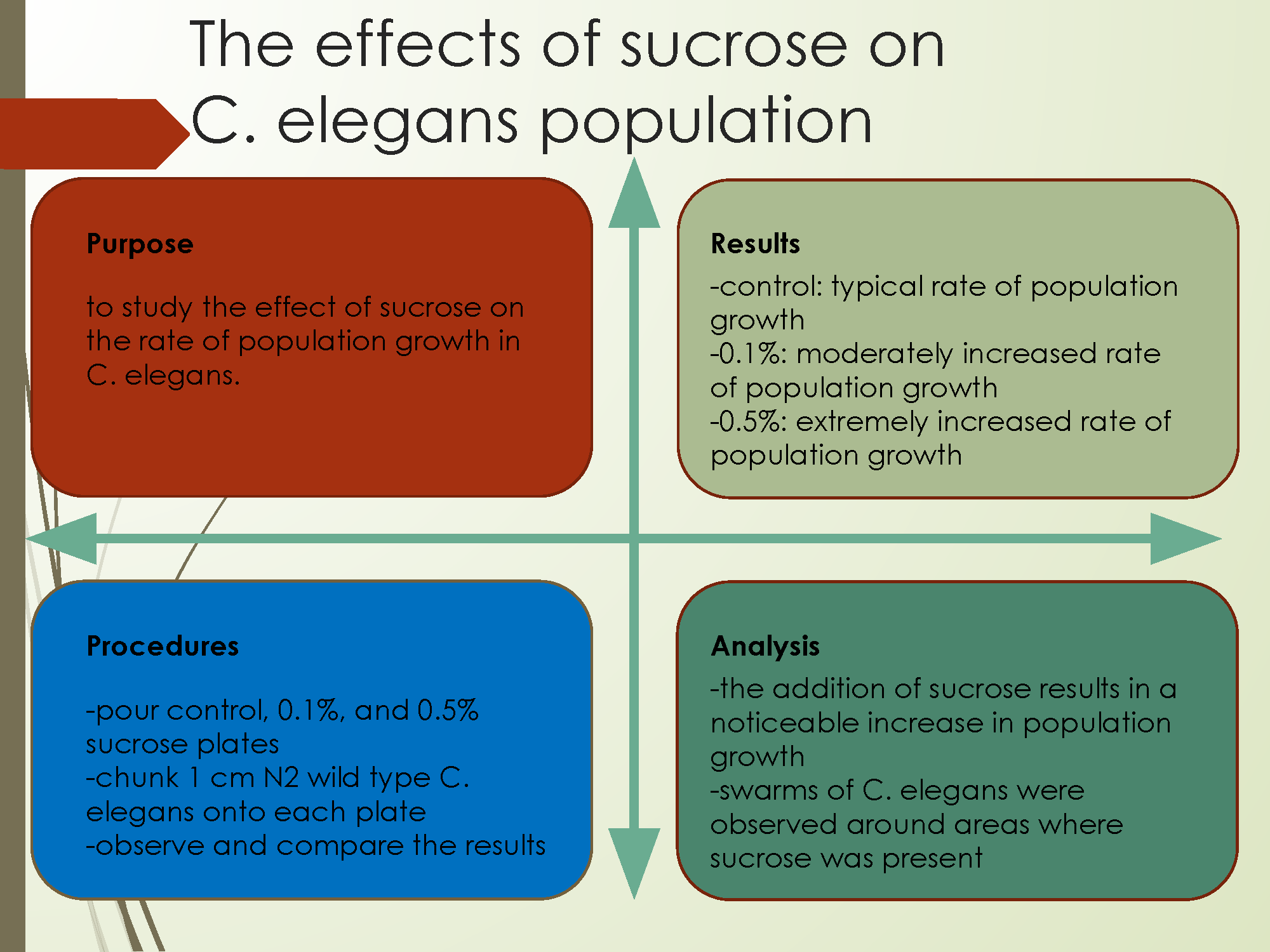The Effect of Diet on the Lifespan of eat-2, daf-16 and Wildtype C. Elegans
Abstract:
Bibliography/Citations:
Driscoll, Monica, and Garth Patterson. “The measurement and analysis of age-related changes in Caenorhabditis elegans.” WormBook, http://www.wormbook.org/chapters/www_measurementanalysisCelegans/measurementanalysisCelegans.html.
“Example.” YouTube, https://www.sigmaaldrich.com/deepweb/assets/sigmaaldrich/product/documents/419/263/cs0730bul.pdf.
Hobert, Oliver. “Methods for measuring pharyngeal behaviors - WormBook - NCBI Bookshelf.” NCBI, https://www.ncbi.nlm.nih.gov/books/NBK126648/.
Kenyon, Cynthia. “Genes that act downstream of DAF-16 to influence the lifespan of Caenorhabditis elegans.” PubMed, https://pubmed.ncbi.nlm.nih.gov/12845331/.
“Losing Paradise.” YouTube, 29 October 2012, https://www.cell.com/current-biology/fulltext/S0960-9822(01)00594-2?_returnURL=https%3A%2F%2Flinkinghub.elsevier.com%2Fretrieve%2Fpii%2FS0960982201005942%3Fshowall%3Dtrue.
Moskalev, Alexey. “DAF-16/FOXO Transcription Factor in Aging and Longevity.” Frontiers, 4 August 2017, https://www.frontiersin.org/articles/10.3389/fphar.2017.00548/full.
Riddle, Donald L. “Dauer.” WormBook, http://www.wormbook.org/chapters/www_dauer/dauer.html.
Additional Project Information
Research Plan:
- Question or Problem being addressed
- The effect of high sugar diets and standard diets on the lifespan and population of wild type C. elegans by studying the rate of reproduction.
- Goals/Expected Outcomes/Hypotheses
- Increased sugar intake will decrease pharyngeal pumping and the rate of reproduction, decreasing the overall lifespan and population. Standard diets will result in an eventual decrease of pharyngeal pumping and increase in the rate of reproduction, resulting in an average lifespan and population.
- Description in detail of method or procedures
- Procedure:
- Obtain wild type C. elegans.
- Pour NGM lite plates
- Obtain sterile dissecting scopes to study pharyngeal pumping and reproduction rate
- Place 1 cm chunk of C. elegans from an E. coli plate into each plate
- Wild Type NGM lite diet with E. coli and 0% fructose dish
- Wild Type NGM lite diet with E. coli and 0.1% fructose dish
- Wild Type NGM lite diet with E. coli and 0.5% fructose dish
- After two to three days, observe the number of worms in each plate.
- Data Analysis:
- Analyze trends in reproduction rate over the lifespan of the differently fed worms
- Calculate the average lifespan of the differently fed worms across each type of worm
- Compare each analysis to determine the effects of each diet on each factor and the overall effect on lifespan length
- Procedure:
- Bibliography
Works Cited
Driscoll, Monica, and Garth Patterson. “The measurement and analysis of age-related changes in Caenorhabditis elegans.” WormBook, http://www.wormbook.org/chapters/www_measurementanalysisCelegans/measurementanalysisCelegans.html.
“Example.” YouTube, https://www.sigmaaldrich.com/deepweb/assets/sigmaaldrich/product/documents/419/263/cs0730bul.pdf.
Hobert, Oliver. “Methods for measuring pharyngeal behaviors - WormBook - NCBI Bookshelf.” NCBI, https://www.ncbi.nlm.nih.gov/books/NBK126648/.
Kenyon, Cynthia. “Genes that act downstream of DAF-16 to influence the lifespan of Caenorhabditis elegans.” PubMed, https://pubmed.ncbi.nlm.nih.gov/12845331/.
“Losing Paradise.” YouTube, 29 October 2012, https://www.cell.com/current-biology/fulltext/S0960-9822(01)00594-2?_returnURL=https%3A%2F%2Flinkinghub.elsevier.com%2Fretrieve%2Fpii%2FS0960982201005942%3Fshowall%3Dtrue.
Moskalev, Alexey. “DAF-16/FOXO Transcription Factor in Aging and Longevity.” Frontiers, 4 August 2017, https://www.frontiersin.org/articles/10.3389/fphar.2017.00548/full.
Riddle, Donald L. “Dauer.” WormBook, http://www.wormbook.org/chapters/www_dauer/dauer.html.
Questions and Answers
1. What was the major objective of your project and what was your plan to achieve it?
a. Was that goal the result of any specific situation, experience, or problem you encountered?
b. Were you trying to solve a problem, answer a question, or test a hypothesis?
2. What were the major tasks you had to perform in order to complete your project?
a. For teams, describe what each member worked on.
3. What is new or novel about your project?
a. Is there some aspect of your project's objective, or how you achieved it that you haven't done before?
b. Is your project's objective, or the way you implemented it, different from anything you have seen?
c. If you believe your work to be unique in some way, what research have you done to confirm that it is?
4. What was the most challenging part of completing your project?
a. What problems did you encounter, and how did you overcome them?
b. What did you learn from overcoming these problems?
5. If you were going to do this project again, are there any things you would you do differently the next time?
6. Did working on this project give you any ideas for other projects?
7. How did COVID-19 affect the completion of your project?

